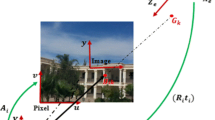Abstract
This study investigates the problem of estimating camera calibration parameters from image motion fields induced by a rigidly moving camera with unknown parameters, where the image formation is modeled with a linear pinhole-camera model. The equations obtained show the flow to be separated into a component due to the translation and the calibration parameters and a component due to the rotation and the calibration parameters. A set of parameters encoding the latter component is linearly related to the flow, and from these parameters the calibration can be determined.
However, as for discrete motion, in general it is not possible to decouple image measurements obtained from only two frames into translational and rotational components. Geometrically, the ambiguity takes the form of a part of the rotational component being parallel to the translational component, and thus the scene can be reconstructed only up to a projective transformation. In general, for full calibration at least four successive image frames are necessary, with the 3D rotation changing between the measurements.
The geometric analysis gives rise to a direct self-calibration method that avoids computation of optical flow or point correspondences and uses only normal flow measurements. New constraints on the smoothness of the surfaces in view are formulated to relate structure and motion directly to image derivatives, and on the basis of these constraints the transformation of the viewing geometry between consecutive images is estimated. The calibration parameters are then estimated from the rotational components of several flow fields. As the proposed technique neither requires a special set up nor needs exact correspondence it is potentially useful for the calibration of active vision systems which have to acquire knowledge about their intrinsic parameters while they perform other tasks, or as a tool for analyzing image sequences in large video databases.
Similar content being viewed by others
References
Anandan, P. 1989. A computational framework and an algorithm for the measurement of visual motion. International Journal of Computer Vision, 2:283–310.
Armstrong, M., Zisserman, A., and Hartley, R. 1996. Self-calibration from image triplets. In Proc. European Conference on Computer Vision, Cambridge, UK, vol. 1, pp. 3–16.
Barron, J.L., Fleet, D.J., and Beauchemin, S.S. 1994. Performance of optical flowtechniques. International Journal of Computer Vision, 12:43–77.
Bergen, J.R., Anandan, P., Hanna, K.J., and Hingorani, R. 1992. Hierarchical model-based motion estimation. In Proc. European Conference on Computer Vision, pp. 237–248.
Black, M. 1994. Recursive non-linear estimation of discontinuous flow fields. In Proc. Third European Conference on Computer Vision, Springer-Verlag, pp. 138–145.
Borisenko, A.I. and Tarapov, I.E. 1986. Vector and Tensor Analysis with Applications. Prentice-Hall: Englewood Cliffs, NJ.
Brodský, T., Fermüller, C., and Aloimonos, Y. 1998a. Self-calibration from image derivatives. In Proc. International Conference on Computer Vision, pp. 83–89.
Brodský, T., Fermüller, C., and Aloimonos, Y. 1998b. Simultaneous estimation of 3D motion and structure. In Proc. European Conference on Computer Vision, pp. 342–358.
Cheong, L., Fermüller, C., and Aloimonos, Y. 1998. Effects of errors in the viewing geometry on shape estimation. Computer Vision and Image Understanding, 71:356–372.
Dron, L. 1993. Dynamic camera self-calibration from controlled motion sequences. In Proc. IEEE Conference on Computer Vision and Pattern Recognition, New York, NY, pp. 501–506.
Faugeras, O.D. 1992. Three-Dimensional Computer Vision. MIT Press: Cambridge, MA.
Faugeras, O.D., Luong, Q.-T., and Maybank, S.J. 1992. Camera self-calibration: Theory and experiments. In Proc. European Conference on Computer Vision, Santa Margherita Ligure, Italy, pp. 321–334.
Fermüller, C. 1993. Navigational preliminaries. In Active Perception, Y. Aloimonos (Ed.). Advances in Computer Vision, Lawrence Erlbaum Associates: Hillsdale, NJ, ch. 3.
Fermüller, C. and Aloimonos, Y. 1995. Direct perception of three-dimensional motion from patterns of visual motion. Science, 270:1973–1976.
Hartley, R.I. 1994a. An algorithm for self calibration from several views. In Proc. IEEE Conference on Computer Vision and Pattern Recognition, pp. 908–912.
Hartley, R.I. 1994b. Self-calibration from multiple views with a rotating camera. In Proc. European Conference on Computer Vision, Stockholm, Sweden, vol. 1, pp. 471–478.
Hartley, R.I. 1997. In defense of the eight-point algorithm. IEEE Transactions on Pattern Analysis and Machine Intelligence, 19:580–593.
Heeger, D.J. and Jepson, A.D. 1992. Subspace methods for recovering rigid motion I: Algorithm and implementation. International Journal of Computer Vision, 7:95–117.
Horn, B.K.P. and Weldon, E.J. Jr. 1988. Direct methods for recovering motion. International Journal of Computer Vision, 2:51–76.
Lenz, R.K. and Tsai, R.Y. 1988. Techniques for calibration of the scale factor and image center for high accuracy 3-D machine vision metrology. IEEE Transactions on Pattern Analysis and Machine Intelligence, 10:713–720.
Maybank, S.J. and Faugeras, O.D. 1992. A theory of self-calibration of a moving camera. International Journal of Computer Vision, 8:123–151.
Mendelsohn, J., Simoncelli, E., and Bajcsy, R. 1997. Discrete-time rigidity constrained optical flow. In Proc. International Conference on Computer Analysis of Images and Patterns, Springer: Berlin, pp. 255–262.
Nagel, H.-H. 1995. Optical flow estimation and the interaction between measurement errors at adjacent pixel positions. International Journal of Computer Vision, 15:271–288.
Nagel, H.-H. and Haag, M. 1998. Bias-corrected optical flow estimation for road vehicle tracking. In Proc. International Conference on Computer Vision, Bombay, India, pp. 1006–1011.
Negahdaripour, S. and Horn, B.K.P. 1987. Direct passive navigation. IEEE Transactions on Pattern Analysis and Machine Intelligence, 9:163–176.
Pollefeys, M., Van Gool, L., and Oosterlinck, A. 1996. The modulus constraint: A new constraint for self-calibration. In Proc. International Conference on Pattern Recognition, Vienna, Austria, vol. A, pp. 349–353.
Spetsakis, M.E. and Aloimonos, J. 1990. Structure from motion using line correspondences. International Journal of Computer Vision, 4:171–183.
Strang, G. 1988. Linear Algebra and Its Applications. Harcourt Brace Jovanovich.
Tsai, R.Y. 1986. An efficient and accurate camera calibration technique for 3D machine vision. In Proc. IEEE Conference on Computer Vision and Pattern Recognition, Miami Beach, FL, pp. 364–374.
Viéville, T. and Faugeras, O.D. 1996. The first-order expansion of motion equations in the uncalibrated case. Computer Vision and Image Understandin g, 64:128–146.
Author information
Authors and Affiliations
Rights and permissions
About this article
Cite this article
Brodský, T., Fermüller, C. Self-Calibration from Image Derivatives. International Journal of Computer Vision 48, 91–114 (2002). https://doi.org/10.1023/A:1016094806773
Issue Date:
DOI: https://doi.org/10.1023/A:1016094806773




